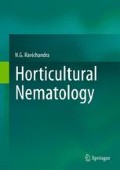Abstract
Nematodes are second only to insects in the number of species in the animal kingdom. However, only about 3 % of all nematode species have been studied and identified. One cubic foot of soil may contain millions of individual nematodes belonging to several different taxonomic groups. Plant-parasitic nematodes are nearly microscopic, worm-shaped animals virtually invisible to the naked eye when in the soil. Phytonematodes can cause significant plant damage ranging from negligible injury to total destruction of plant material. The severity of plant injury resulting from nematode activity depends on several factors such as the combination of plant and nematode species and prevailing environmental factors including rainfall, soil types, land contour, and culture practices.
Access this chapter
Tax calculation will be finalised at checkout
Purchases are for personal use only
References
Decraemer, W., & Hunt, D. J. (2006). Structure and classification. In R. N. Perry & M. Moens (Eds.), Plant nematology (pp. 3–32). Wallingford/Cambridge, MA: CABI Publisher.
Handoo, Z. A. (1998). Plant-parasitic nematodes. http://www.ars.usda.gov/Services/docs/htm
Koenning, S. R., Overstreet, C., Noling, J. W., Donald, P. A., Becker, J. O., & Fortnum, B. A. (1999). Survey of crop losses in response to phytoparasitic nematodes in the United States for 1994. Journal of Nematology, 31, 587–618.
Nicol, J. M. (2002). Important nematode pests of cereals. In B. C. Curtis, S. Rajaram, & G. Macpherson (Eds.), Bread wheat- improvement and production (FAO plant production and protection series, no. 30, pp. 345–366). Rome: FAO.
Powell, N. T. (1971). Interactions between nematodes and fungi in disease complexes. Annual Review of Phytopathology, 9, 253–274.
Ravichandra, N. G. (2008). Plant nematology (695 pp). New Delhi: I.K. International Pvt. Ltd.
Reddy, P. P. (2008). Diseases of horticultural crops: Nematode problems and their management (379 pp). Jodhpur: Scientific Publishers.
Sasser, J. N., & Freckman, D. W. (1987). A world perspective on nematology: The role of the society. In J. A. Veech & D. W. Dickson (Eds.), Vistas on nematology (pp. 7–14, 509 pp). Hyattsville: Society of Nematologists.
Stirling, G. R., Nicol, J. M., & Reay, F. (1998). Advisory services for nematodes pests – Operational guide (Rural Industries Research and Development Corporation Publication No. 99/41, 120pp.), Canberra.
Whitehead, A. G. (1998). Plant nematode control. Wallingford: CAB.
Author information
Authors and Affiliations
Rights and permissions
Copyright information
© 2014 Springer India
About this chapter
Cite this chapter
Ravichandra, N.G. (2014). Phytonematodes: Threat to Horticulture. In: Horticultural Nematology. Springer, New Delhi. https://doi.org/10.1007/978-81-322-1841-8_2
Download citation
DOI: https://doi.org/10.1007/978-81-322-1841-8_2
Published:
Publisher Name: Springer, New Delhi
Print ISBN: 978-81-322-1840-1
Online ISBN: 978-81-322-1841-8
eBook Packages: Biomedical and Life SciencesBiomedical and Life Sciences (R0)

